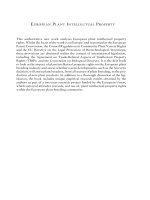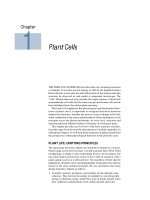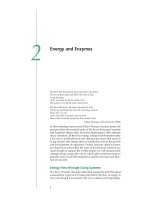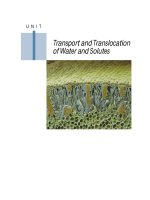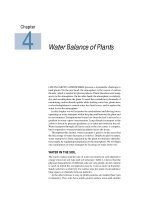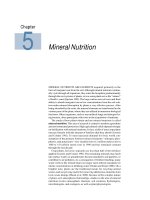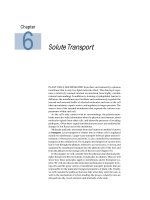- Trang chủ >>
- THPT Quốc Gia >>
- Hóa
Plant processes
Bạn đang xem bản rút gọn của tài liệu. Xem và tải ngay bản đầy đủ của tài liệu tại đây (4.08 MB, 10 trang )
Genre
Nonfiction
Comprehension Skill
Compare and
Contrast
Text Features
•
•
•
•
Labels
Captions
Diagrams
Glossary
Science Content
Plants
Scott Foresman Science 6.5
ISBN 0-328-13983-1
ì<(sk$m)=bdjidf< +^-Ä-U-Ä-U
Vocabulary
cellular respiration
epidermis
guard cell
phloem
photosynthesis
stoma
transpiration
tropism
xylem
Picture Credits
Every effort has been made to secure permission and provide appropriate credit for photographic material.
The publisher deeply regrets any omission and pledges to correct errors called to its attention in subsequent editions.
Photo locators denoted as follows: Top (T), Center (C), Bottom (B), Left (L), Right (R), Background (Bkgd).
Opener: ©Comstock Inc.; 1 Dr Jeremy Burgess/Photo Researchers, Inc.;
5 (BL, BC) Dr Jeremy Burgess/Photo Researchers, Inc.; 6 (T) ©Comstock Inc.; 13 (T) Digital Vision.
Unless otherwise acknowledged, all photographs are the copyright © of Dorling Kindersley, a division of Pearson.
ISBN: 0-328-13983-1
Copyright © Pearson Education, Inc. All Rights Reserved. Printed in the United States of America.
This publication is protected by Copyright, and permission should be obtained from the publisher prior to any
prohibited reproduction, storage in a retrieval system, or transmission in any form by any means, electronic,
mechanical, photocopying, recording, or likewise. For information regarding permission(s), write to
Permissions Department, Scott Foresman, 1900 East Lake Avenue, Glenview, Illinois 60025.
3 4 5 6 7 8 9 10 V010 13 12 11 10 09 08 07 06 05
What did you learn?
1. List the three main parts of a plant. Describe
what they do.
2. Leaves make food. What is this food called?
3. Why are mitochondria called the powerhouse
of a cell?
4.
Seeds and spores reproduce
in different ways. Write to explain how they
reproduce. Use examples from the book to
support your answers.
5.
Compare and Contrast photosynthesis and
by Jean
Szeto
cellular respiration? How
are they
the same? How
are they different?
The Parts Of
A Vascular Plant
What anchors a plant and absorbs minerals
and water from soil? That is the job of the plant’s
roots. What do leaves do? The plant’s leaves use water
to make food in the form of glucose. Why is the stem
important? A plant’s stem supports the plant and
transports water, minerals, and glucose.
A vascular plant has tiny tubes that transport
liquids, such as water and glucose. The roots, leaves,
and stems all contain these tiny tubes.
leaf
red-cabbage
plant
Roots
You have probably seen flowers moving when the wind
blows. Why don’t they blow away? The flowers are held in
place by their underground roots. Roots help the plant stay
secure in the ground. They start
from the base of the plant and
spread in the soil. There are
many types of root.
Some plants have only one
main root, with many tiny roots
growing from it. This type of
root is called a taproot. Dandelions
have taproots. Other plants
have many smaller roots that
spread out like tiny arms.
dandelion plants
taproot
network of
small roots
Most roots are in the soil, which
contains water and minerals. Water and
minerals enter the root through a thin
outer layer of cells called the epidermis.
The epidermis has root hairs that help the root
absorb water from the soil. If the epidermis did
not have root hairs, it would absorb less water.
Nutrients move from the epidermis to the xylem.
The xylem, a type of vascular tissue, moves water
and minerals from the roots to other plant parts.
Some plants, such as certain orchids, have aerial roots,
which extract moisture from the air.
Plants make their own food. The leaves of a plant
make a type of sugar called glucose. Another type of
vascular tissue is phloem, which moves glucose to the
different parts of the plant. Roots store some of this glucose
in the form of starch. Beets are roots that store food.
stem
epidermis (outer
layer of cells)
phloem
xylem
cross section of a lily plant root
2
3
Stems
Stems come in different forms. They can be tall or short,
rough or smooth, curved or straight. Stems support plants.
Like roots, they have xylem and phloem. The xylem and
phloem move water, minerals, and glucose between the roots
and the leaves of the plant.
Some stems are green and easy to bend. Plants with this
type of stem are called herbaceous plants. The leaves and
stems of these plants can die in cold weather, but their roots
keep on living underground. Each year, these plants grow new
stems. Strawberries, grasses, and weeds are herbaceous plants.
Other stems are strong and thick. Plants with this
type of stem are called woody plants.
These plants grow to be large and live
for a long time. A woody plant may
lose its leaves for part of the year, but
its stem remains alive. Examples of
woody plants are trees, shrubs, and vines.
woody stem
of sycamore tree
Jerusalem artichoke
4
green-stemmed
strawberry plant
There are also stems that grow under the
ground. A Jerusalem artichoke is an underground
stem called a tuber. Potatoes are another example
of underground stems. Food stored in tubers
helps the plant to survive. For example, if it does
not rain enough or it is too cold, a plant may not
make enough sugar. It survives because it has
a store of food in its tubers.
Leaves
Leaves come in all shapes and sizes. But
the function they all have in common is that
they make food for plants. As leaves make
a food called glucose, water and gases travel
in and out of the plant through tiny holes
in the leaf’s epidermis. Each hole is called
a stoma (plural: stomata). The cell that opens
and closes a leaf’s stoma is a guard cell.
Sunlight can cause guard cells to take in water.
The water that is taken in through the guard cells
puts pressure on their walls. This increased pressure
causes the shape of the guard cells to become curved.
Once the guard cells curve, the stomata open.
A guard cell usually closes Then the guard cell opens
a leaf’s stoma at night.
the stoma during the day.
5
How do plants
get and use energy?
Leaves make glucose, which contains energy. Cells break
down this energy. The plant uses the energy to live and grow.
Water escapes
from the leaves.
Transpiration
When stomata open, gases from the air
enter the leaf and water passes out of the
leaf. The loss of water from the leaf is called
transpiration. The amount of water lost during
transpiration depends on air temperature,
wind, and the amount of water
in the air and the soil.
To survive, the plant needs
to replace the water lost during
Xylem in the
transpiration. As water exits
stem carries
a leaf, more water is taken
water to
the leaves.
into the leaf. This movement
pulls more water up through
the xylem in the stem.
The plant can take in more water
through its roots. If more water is lost
by transpiration than is gained by the roots,
the plant may wilt and even die.
Roots absorb water
from the soil.
6
Photosynthesis
Different flowers have different colors, but most leaves are
green at some stage in their life. Why are leaves green?
A chloroplast is a tiny structure found inside most plant cells.
It contains a substance called chlorophyll, which makes leaves and
other parts of plants green. Chlorophyll also allows a plant to make
its own food in the form of glucose. Animal cells do not have chlorophyll,
so they are usually not green and cannot make their own food.
Photosynthesis is the process in which plants make glucose.
During photosynthesis, chlorophyll uses light energy from the Sun,
carbon dioxide from the air, and water to form glucose and oxygen.
Energy is stored in glucose, which plants use for life processes. When
organisms eat plants, they use glucose as energy too. The process of
photosynthesis is summarized in this equation.
carbon dioxide + water
Oxygen escapes
into the air.
light energy
chlorophyll
glucose + oxygen
Sunlight provides
energy for
photosynthesis.
Glucose is
carried away.
Water enters
from the roots.
Carbon dioxide
enters from the air.
7
Energy from Food
The Structure of a Leaf
The process of photosynthesis requires
light energy from the Sun.
The cuticle is a waxy layer.
It may cover the leaf and
slow water loss.
The epidermis, which covers the
top and bottom of the leaf, allows
light to pass easily into the middle
of the leaf.
Photosynthesis takes place in
the middle of the leaf. Tall, thin
cells absorb sunlight. These cells
contain many of the chloroplasts
that a plant needs to make glucose.
Phloem is found in the veins of
the leaf. Glucose made by the leaf
moves around the plant through
the phloem.
Xylem, also found in the veins,
allows water and minerals to
enter the leaf.
The cells in the lower part of the leaf
are widely spaced. Air spaces that
surround the cells allow carbon
dioxide to move freely throughout
the leaf. The carbon dioxide is
needed for photosynthesis.
When it is sunny outside, plants can make more glucose
than they need. Extra glucose can be changed into other kinds
of sugars and starches, which plants store.
When they need to use the stored foods, plants break
down the sugars and starches to release the energy they contain.
All organisms must break down food to release stored energy.
This process is called cellular respiration.
Cellular respiration starts in the cytoplasm of cells. Cytoplasm
is the jellylike fluid inside cells. Glucose in the cytoplasm is
broken down into simpler substances. If cells contain oxygen,
the simpler substances move into parts of the cell called
mitochondria. In a mitochondrion, oxygen further breaks down
the simpler substances. This entire process produces carbon
dioxide and water. It also releases energy. Because mitochondria
release energy, they are sometimes called the powerhouse of a cell.
The process of cellular respiration is summarized in this equation.
glucose + oxygen
mitochondrion
carbon dioxide + water + energy
nucleus, the control
center of the cell
cell wall
cytoplasm
Stomata are usually found on the
lower part of the leaf. Since less
light reaches under the leaf, the
lower part is cooler and less water
is lost through transpiration.
guard cell
8
cross section
of a plant cell
chloroplast
9
Carbon Dioxide–Oxygen Cycle
Have you noticed that the equations for photosynthesis and
cellular respiration look similar? Let’s look at the equations again.
Photosynthesis:
carbon dioxide + water
light energy
chlorophyll
glucose + oxygen
Cellular respiration:
glucose + oxygen
carbon dioxide + water + energy
The two processes are almost the reverse of each other!
Photosynthesis uses carbon dioxide, water, and energy to produce
glucose and oxygen. Cellular respiration uses glucose and oxygen to
produce carbon dioxide, water, and energy. If one process ended,
the other process would not happen. Photosynthesis and cellular
respiration form a cycle, called the carbon dioxide–oxygen cycle.
Animals breathe oxygen from the air. Plants take in oxygen
through leaves. During respiration, animals and plants use oxygen
to change energy in food to energy they can use. Plants use the
energy to produce more food and oxygen during photosynthesis.
The carbon dioxide–oxygen cycle ensures that there is enough
oxygen and carbon dioxide for each process to happen.
animals
oxygen
respiration
plants
photosynthesis
10
How do seeds
and plants grow?
Some seeds are made inside flowers. Other seeds develop
inside cones. Different plants need different conditions in order
to grow. Plants’ behavior depends on the environment.
Plants with Seeds
In a plant that produces seeds,
the first step of growth occurs when
a tiny seedling emerges from a seed.
Angiosperms are seed plants that
produce flowers. Angiosperms are
very common—scientists have found
between 200,000 and 300,000 species
of them! Only insects have more species
than angiosperms. Apples and tulips
are examples of angiosperms.
Angiosperms are vascular plants.
This means they have special tissues—
xylem and phloem—that move
materials around the plant. Most
angiosperms develop seeds inside
a fruit. The fruit protects the seeds.
Humans use angiosperms in many
ways. We use them as food crops and
in medicine. Lumber, perfume, and
some fabrics are also products
made from angiosperms.
Flowering plants and apples
are both angiosperms.
carbon
dioxide
11
Seeds can also grow inside cones. Gymnosperms
are plants that produce their seeds in cones. Unlike
angiosperms, gymnosperms do not produce flowers.
Gymnosperms live a long time—even thousands of years!
One common type of gymnosperm is the conifer.
Conifers are woody plants that often have long, thin leaves
called needles. The Scotch pine is a type of conifer.
Conifers have two types of cones—male and female.
Female cones have ovules with egg cells. Male cones make
pollen that contains sperm. Pollen, often blown by the wind,
moves from male cones to female cones. Sperm then
fertilize the egg cells. Once it has been fertilized, the female
cone closes up and develops seeds. It can take two years for
seeds to mature fully. Then the cone opens and the seeds are
released. There is no fruit to protect gymnosperm seeds.
Many products, such as wood, paper products,
and paint, are made from gymnosperms. Oil from
gymnosperms is used in everyday
products such as air fresheners
and soaps. Gymnosperm
seeds are also a source
of food.
The Scotch pine is
a gymnosperm,
which produces
seeds inside cones.
12
Germination
And Growth
A seed contains a tiny
developing plant called an
embryo. The seed coat protects
the embryo. Before it can fully
develop, the embryo must wait
until conditions are suitable
for germination. Germination
is the process of growth from
seed to plant.
Different plants need
different conditions to grow.
Temperature affects the
germination of plants. Most
seeds that grow in cold climates
do not germinate until the
spring or early summer, when
the air and soil are warmer.
However, some seeds that
germinate in cold, dry climates
do not need much warmth or
moisture. Seeds in tropical
rain forests do need a great
deal of moisture and high
temperatures to germinate.
13
The seed coat containing the plant embryo breaks open
when it becomes too small to contain the growing plant.
This allows more oxygen and water to reach the plant.
When the plant cells have more oxygen, they grow larger
and break apart to form new cells, helping the plant to grow.
The extra water also helps the plant to grow. However, too
much moisture can harm the plant, if there is not enough
oxygen to balance out the dampness. Seeds with too much
moisture may not grow. They may rot instead.
To protect the plant during poor growing conditions, some
seeds become inactive. Inactive seeds often survive conditions
that would kill a plant. For example, some seeds
can survive droughts, freezing temperatures,
and even forest fires!
When seeds germinate, roots grow
downward. At the same time, the stem grows
upward. New cells develop at the tips of
developing
the roots and stem, and plants get bigger.
leaves
Branches on a plant’s stem grow from side
stem grows
buds. Some plants increase in width too.
upward
To help with the growing process, cells divide
to repair damaged tissue in the plant.
seed coat
germination of
a runner-bean plant
14
roots grow
downward
Some plants do not grow from seeds. Mosses and
ferns produce spores, not seeds. The table below shows
how spores and seeds are different. Like seeds, spores can
become plants only if conditions are right. Wet conditions
suit most spore-producing plants.
Spore
Seed
contains a single cell that
grows into a new plant
contains a multicellular embryo
that develops into a new plant
does not contain stored food
contains stored food
is usually very small
can vary in size
Tropism: Responding To
The Environment
Why do roots grow down and stems grow up? Plants, like
all living organisms, respond to the environment. Although plant
behavior is hard to see, it certainly exists. Have you seen plants
that bend, turn, droop, or twist? This turning or bending is called
tropism.
Plants do not have nerves to control behavior as animals do.
Instead, the chemicals that plants make can cause different
behavior. For instance, chemicals can cause cells in different
parts of the plant to grow at different rates. Cells on one side of
a stem may grow very quickly. Cells on the opposite side may
grow very slowly. This uneven growth causes a stem to bend.
Tropism is the plant’s response to the environment.
15
Vocabulary
Glossary
cellular respiration
epidermis
guard cell
cellular
the process by which cells break
phloem
respiration
down food with the release of energy
photosynthesis
stoma
epidermis
a thin outer layer of cells
transpiration
tropism
guard cell
a cell that opens and closes a leaf’s stoma
xylem
phloem
a group of cells that carry glucose, produced
by the leaves, throughout the plant
photosynthesis
the process by which plants make glucose
stoma
the small hole in the epidermis of a leaf
(plural: stomata)
transpiration
the loss of water from a leaf
tropism
the turning or bending movement of
a living organism
xylem
a group of cells that move water and minerals
from the roots to other parts of the plant
Picture Credits
Every effort has been made to secure permission and provide appropriate credit for photographic material.
The publisher deeply regrets any omission and pledges to correct errors called to its attention in subsequent editions.
Photo locators denoted as follows: Top (T), Center (C), Bottom (B), Left (L), Right (R), Background (Bkgd).
Opener: ©Comstock Inc.; 1 Dr Jeremy Burgess/Photo Researchers, Inc.;
5 (BL, BC) Dr Jeremy Burgess/Photo Researchers, Inc.; 6 (T) ©Comstock Inc.; 13 (T) Digital Vision.
Unless otherwise acknowledged, all photographs are the copyright © of Dorling Kindersley, a division of Pearson.
ISBN: 0-328-13983-1
Copyright © Pearson Education, Inc. All Rights Reserved. Printed in the United States of America.
This publication is protected by Copyright, and permission should be obtained from the publisher prior to any
prohibited reproduction, storage in a retrieval system, or transmission in any form by any means, electronic,
mechanical, photocopying, recording, or likewise. For information regarding permission(s), write to
Permissions Department, Scott Foresman, 1900 East Lake Avenue, Glenview, Illinois 60025.
3 4 5 6 7 8 9 10 V010 13 12 11 10 09 08 07 06 05
16
What did you learn?
1. List the three main parts of a plant. Describe
what they do.
2. Leaves make food. What is this food called?
3. Why are mitochondria called the powerhouse
of a cell?
4.
Seeds and spores reproduce
in different ways. Write to explain how they
reproduce. Use examples from the book to
support your answers.
5.
Compare and Contrast photosynthesis and
cellular respiration? How are they the same? How
are they different?



